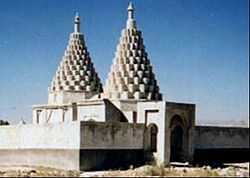Bastak
| Bastak بستك | |
|---|---|
| city | |
|
Tomb of Shikh AbdulRahman Buzorg in Kukherd | |
 Bastak | |
| Coordinates: 27°11′57″N 54°22′00″E / 27.19917°N 54.36667°ECoordinates: 27°11′57″N 54°22′00″E / 27.19917°N 54.36667°E | |
| Country |
|
| Province | Hormozgan |
| County | Bastak |
| Bakhsh | Central |
| Population (2006) | |
| • Total | 8,376 |
| Time zone | IRST (UTC+3:30) |
| • Summer (DST) | IRDT (UTC+4:30) |
Bastak (Persian: بستک; also known as Bustak)[1] is a city in and the capital of Bastak County, Hormozgan Province, Iran. Bastak was traditionally part of the region of Larestan. Bastak's inhabitants are Larestani people. Bastak's inhabitants speak Bastaki, a dialect of Larestani.
At the 2006 census, its population was 8,376, in 1,765 families.[2]
History of Bastak
The history of Bastak can be traced back to the Safavids era. When the Safavids under Ismail I decided to convert everyone residing in current day Iran from Sunni to Shiite Islam in 1501, they started arranged attacks and massacres against the Sunni Persians who refused to convert. As a result, many Sunni Persians left their hometowns for the Zagros Mountains. After the Battle of Chaldiran where the Safavids lost to the Ottoman the Sunni Persians descended from the mountains to begin a new life in the land they named "Bastak", meaning barrier or backstop signifying barrier from Shiite Safavids' attacks and influences.
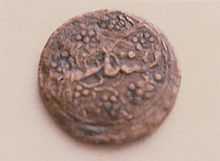
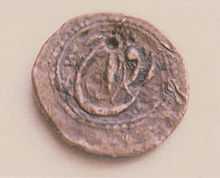
Eventually, they pledged loyalty to the Abbasids, a Muslim dynasty that left Baghdad after the Moghol invasion towards the southern mountains of Persia. The rulers of Shiraz at the time, the Atabak, gave them protection to pass through their lands as they fled from the Moghols. Later on the Abbasids they took permission from Atabak to establish a state of their own and rule Bastak and the surrounding villages and islands. It was said that a few Hashimites (descendants of Prophet Mohammed) moved to Bastak from Khonj where they had settled after leaving Iraq towards Persia. The Abbasids carried on the expansion of Bastak's rule until it included more than 60 villages and many islands in the Persian Gulf. Many alliances were formed between the Bastaki Persians and the Arab rulers in the current day UAE.
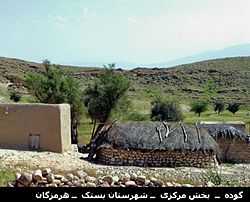
Bastakis in the Persian Gulf
Many Bastakis emigrated to Dubai, Bahrain, and Kuwait after refusing to pay taxes to Nasir al-Din, the last member of the Qajar dynasty and refusing to give up their Sunni faith. Today, there are many Bastakis in Dubai, Bahrain, Kuwait, Qatar and Oman, who have carried their unique Persian culture, language, and architecture with them. They have named their neighbourhood in Dubai, Bastakeyah, after their small city of Bastak, and use an old style of Persian architecture that is represented in the Badgir ("wind catchers") that direct the wind into the houses and cool the interior of the houses, a very common style throughout the Persian Gulf. In Bahrain they settled mostly in and around Awadhiya which is now a busy commercial district. The neighborhood contains some of the last remaining houses built in the traditional architectural style featuring badgeer windtowers in Bahrain.
See also
- Larestan
- Lari people (Iran)
- Khonj County
- Gerash County
- Lamerd County
- Evaz
Gallery
-
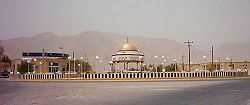
Kemeshk Square, Bastak
-
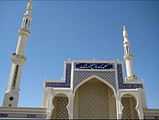
-
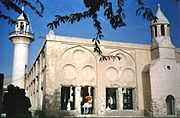
-
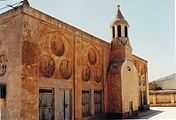
-
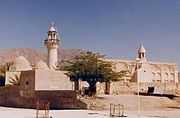
-
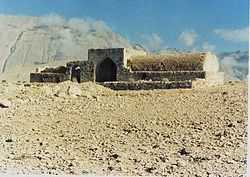
-
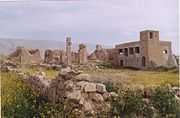
-
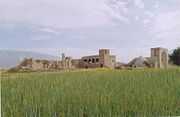
-
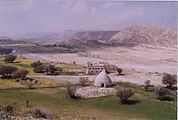
Notes
- ↑ Bastak can be found at GEOnet Names Server, at this link, by opening the Advanced Search box, entering "-3055745" in the "Unique Feature Id" form, and clicking on "Search Database".
- ↑ "Census of the Islamic Republic of Iran, 1385 (2006)" (Excel). Islamic Republic of Iran. Archived from the original on 2011-11-11.
References
- الكوخردى ، محمد ، بن يوسف، (كُوخِرد حَاضِرَة اِسلامِيةَ عَلي ضِفافِ نَهر مِهران) الطبعة الثالثة ،دبى: سنة 199۷ للميلاد Mohammed Kookherdi (1997) Kookherd, an Islamic civil at Mehran river, third edition: Dubai
- محمدیان، کوخری، محمد ، “ (به یاد کوخرد) “، ج1. ج2. چاپ اول، دبی: سال انتشار 2003 میلادی Mohammed Kookherdi Mohammadyan (2003), Beyade Kookherd, third edition : Dubai.
- محمدیان، کوخردی ، محمد ، «شهرستان بستک و بخش کوخرد» ، ج۱. چاپ اول، دبی: سال انتشار ۲۰۰۵ میلادی Mohammed Kookherdi Mohammadyan (2005), Shahrestan Bastak & Bakhshe Kookherd, First edition : Dubai.
- عباسی، مصطفی قلی. «بستک وجهانگیریه»، چاپ اول، تهران : ناشر: شرکت انتشارات جهان
- سلامى، بستكى، احمد. (بستک در گذرگاه تاریخ) ج2 چاپ اول، 1372 خورشيدى
- اطلس گیتاشناسی استانهای ایران [Atlas Gitashenasi Ostanhai Iran] (Gitashenasi Province Atlas of Iran)
External links
| Wikimedia Commons has media related to Bastak. |
| ||||||||||||||||||||||||||||||||||||||||||||||||||||||||||||
| ||||||||||||||||||||||||||||||||||||||||||||||||||||||||||||||||||||||
